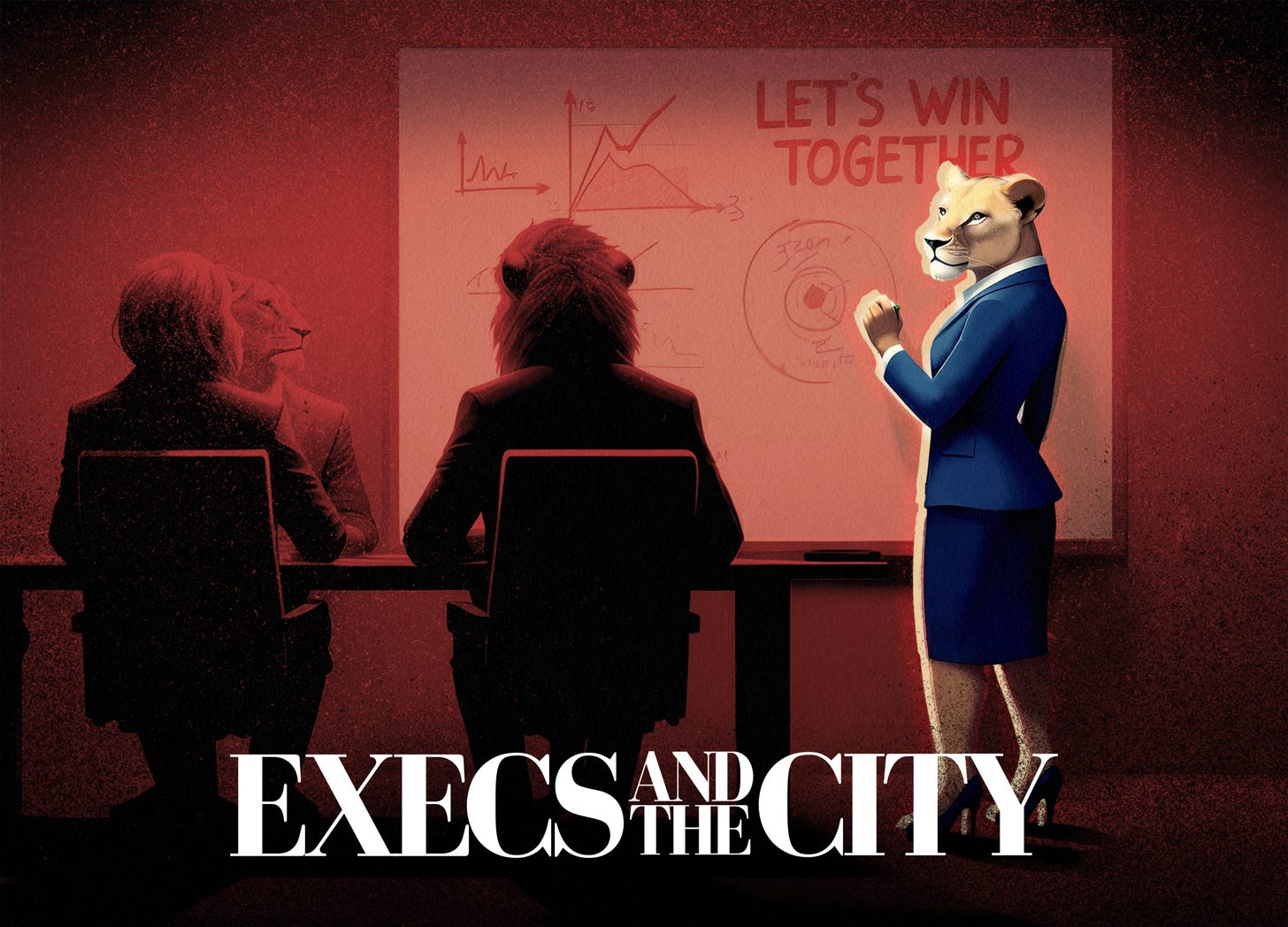The Real Reason You're Underpaid (It's Not Market Data)
Why senior leaders command premium compensation through value and influence, not data—especially when benchmarks fail to capture actual worth.
A paid subscriber sent me a question that exposes a career challenge benchmarking frameworks consistently fail to address.
She’s a C-Suite officer at a family-owned services firm where she’s built nearly every core function over seven years.
Strong indications of being undervalued, but traditional benchmarks don’t apply to her situation.
The CXO title varies wildly in her industry, and comparable organizations rarely publish compensation data.
She’s exploring larger organizations with clearer structure but faces the emotional and practical weight of leaving a family-run environment.
Her three questions cut to the core of what many senior leaders face:
How do I determine true market value when my role, title, and industry don’t map to traditional surveys?
How do I decide between staying where growth feels limited versus pursuing opportunities with an accelerated trajectory?
What frameworks support the next decade of my career, not just the next year?
Her situation is specific, but the psychology is universal.
Whether you’re at a family business, a niche industry player, or holding a newly created executive function, you’ve likely faced the same fundamental problem—or you’re simply feeling underpaid and need help addressing the conversation.
Last week we discussed escaping salary band constraints.
This week addresses what happens when those bands don’t exist at all—or worse, when they exist but fail to capture the value you actually create and keep you trapped.
Why Data Feels Safer (And Why It Fails You)
Family businesses, niche industries, and newly created executive functions increasingly define modern senior leadership. Yet compensation philosophy remains anchored to historic job categories that no longer match reality.
When traditional benchmarks fail, we feel unmoored.
We seek anchors because facing uncertainty is hard, and conflict can be terrifying—especially when threats to our financial well-being trigger the closest thing to a fight-or-flight response in our modern lives.
We haven’t been taught how to have value-based conversations, so we fear confrontation or coming across as difficult.
Pointing to “objective” third-party data feels safer.
It removes us from blame.
It’s commodity thinking.
When no “official” benchmark exists, we create makeshift anchors:
“Other CXOs in different industries earn X...”
“My friend with comparable experience makes Y...”
“Glassdoor shows Z for similar titles...”
Anchors feel better than nothing.
Even official-seeming compensation surveys, with their impressive methodologies, trigger our automatic deference.
But this is a psychological trap.
Humans are wired for social comparison.
Studies on relative income preferences reveal a counterintuitive fact: many people would rather earn $50K when their peers earn $25K than earn $100K when their peers earn $200K.
We care more about our relative position than our absolute wealth.
This wiring creates a devastating pattern.
Picture the thought process: You know you’re undervalued. You spend a Saturday night scrolling Pave data or scanning industry surveys, looking for validation.
You find a “VP of Operations” role at a mid-sized competitor. The salary listed is $220K.
Immediately, your brain recalibrates.
$220K feels like a “realistic” ceiling. This is the Anchoring Bias—our tendency to rely too heavily on the first piece of information offered.
You’re anchored low. You tell yourself, “Maybe $275K is too aggressive.”
You enter the negotiation asking for $230K, having already defeated yourself before the conversation even begins.
You negotiated based on the average salary of a stranger, rather than the specific value you deliver to your company.
The reader’s situation exposes this perfectly.
Seven years of building core functions, but “conversations about advancement or compensation are deprioritized.”
That’s not accidental.
That’s family business psychology—where relationship preservation often trumps compensation optimization.
Makeshift anchors and official surveys share the same fundamental flaw.
They provide false precision while constraining your thinking. They fail to account for the most important information—your unique situation, the value you create, and the specific drivers, motivations, and influence patterns of the people around you.
This is why business owners get frustrated when you enter a negotiation armed with third-party data; they know those rules don’t apply to your bespoke role.
So why are you hiding behind them?
You’re not taking the coward’s path—you’ve made tough choices to get where you are. But relying on benchmarks when they can’t capture your value keeps you trapped in someone else’s framework.
The executives who thrive in these situations master value conversations.
Senior leaders command premium compensation by influencing stakeholders, developing champions, and persuading decision-makers.
They don’t find better benchmarks.
They build a case that makes benchmarks irrelevant.
Your Leverage Is Greater Than You Think
Traditional compensation thinking operates on replacement logic—what would it cost to swap you out?
This treats you like a standard part in a machine.
If a hard drive burns out, the company checks the market price for that hard drive and swaps it out.
That’s commodity thinking.
But you aren’t the hard drive. You are the operating system.
You were custom-coded for this specific machine over seven years. If you are removed, the machine doesn’t just lose storage capacity; it stops functioning entirely.
You cannot price a custom operating system using the market rate for a hard drive.
Value creation asks a different question:
How much is it worth to keep the machine running smoothly?
What expensive problems do I solve that wouldn’t get solved without me?
What revenue, cost, or risk outcomes exist because of my specific contributions?
What operational capacity exists now that didn’t exist before I built it?
How would this company operate without me—would it fundamentally change?
How difficult would I be to replace?
What would happen to these systems without a succession plan?
When you argue based on replacement logic, you invite the company to view you as a commodity.
Commodity thinking sounds like this: “A Head of Operations in this region typically earns $200K. Given my experience, I believe $220K is fair.”
You are focusing on the price of a role.
Value creation sounds like this: “Last year, the systems I built reduced our operating costs by 15%—that’s $450K saved. The new service line I launched is projected to generate $1.2M this year. I’m asking for compensation that reflects that impact.”
You are focusing on the value of the outcomes.
Family-owned businesses face greater talent challenges because they aren’t as compelling for experienced executives to join.
For the executive who has spent seven years embedding themselves into the infrastructure, this scarcity creates a moat.
You aren’t just hard to replace; you are structurally indispensable.
They likely don’t have the clout to naturally attract talent—and typically lack the resources to engage in a meaningful executive search through a high priced firm.
Additionally, lesser-known brands complicate the “career narrative” for mercenary senior leaders.
It requires answering what the company is and why one would go there—justifications never required for a stint at Google or other household brands.
This slows down future opportunities and makes moving fluidly through the market more challenging.
It creates a quiet anxiety—the fear that your experience won’t translate, and that seven years of ‘wearing every hat’ looks messy to recruiters scanning for recognizable logos.
But family owned companies often offer something institutional orgs can’t—real autonomy, cultural flexibility, and the chance to build entire functions rather than optimize someone else’s system.
The trade-offs aren’t purely financial.
The question isn’t which is better.
It’s which trade-offs serve your next decade best.
Building Your Value Case
You need to document what value exists because of you.
Three categories matter: revenue impact, cost reduction, and organizational capacity.
Revenue impact isn’t simply sales quotas. It’s the $5M anchor client that only stays because of your personal relationship. It’s the new product line you conceptualized—against internal resistance—that now accounts for 20% of revenue.
Cost reduction isn’t about optimizing the budget. It’s the inventory management system you designed that cut fulfillment time by 40%, reducing headcount needs. It’s the $100K compliance fine you avoided because you proactively identified a regulatory shift.
Organizational capacity is the infrastructure you built. It’s the entire finance department you built from scratch. It’s the three directors you mentored who now run operations independently—allowing the owners to take their first vacation in five years.
The test: Could someone step into your role tomorrow and immediately access all this value? Or would it evaporate because it’s built on your specific relationships, knowledge, and capabilities?
If it would evaporate, you’re not a replaceable resource. You’re a value creation engine.
That’s leverage. Price accordingly.
But a critical caveat: Leverage is not a weapon.
Do not walk into the room swinging this reality around like a hammer. You don’t need ultimatums. Ultimatums create adversaries; value creates partners.
Your goal is to use this leverage to defuse the tension, not ignite it.
By clearly articulating the risks you mitigate and the revenue you protect, you aren’t making a demand—you are de-risking the decision for them to pay you more.
Now look backward and forward.
Pull out your calendar from five years ago.
Document what functions and systems existed then versus now.
What crises happened that you navigated?
What opportunities materialized because you spotted them?
What strategic directions the company took based on your influence?
Now calculate what the organization’s financial position would be if those outcomes hadn’t happened.
Now look six months forward. If you left tomorrow, what actually happens on Tuesday?
Visualize the Monday morning meeting after your departure. The CEO asks for the Q4 pipeline analysis—the comprehensive report you usually generate.
Silence.
Imagine the operations team trying to navigate the complex, custom-built system you designed, realizing no one else knows how it truly works.
Consider that major client—the one who only trusts you—calling with an urgent problem and finding out you’re gone.
Panic.
That chaos isn’t ego. It’s the sound of value evaporating.
To accurately price that value, you need to assess the total cost of your absence. Look beyond your job description and quantify the organizational drag your departure would create:
Knowledge and Institutional Memory
What critical processes are completely undocumented and live only in your head?
Which systems would break down because no one else understands the complex logic or “workarounds” behind how they were built?
How much historical context about past failures (and why they failed) would evaporate with you, causing the company to repeat expensive mistakes?
Risk and Hidden Dependencies
What operational fires do you routinely extinguish before leadership even smells smoke?
What “invisible risks” (compliance, regulatory, security) are you currently mitigating that others are likely to miss?
Which departments would slow down because they rely on your ability to cut through red tape or navigate internal politics?
Relationship Capital and Financial Impact
How much annual revenue is tied directly to client or investor relationships that only you manage?
Which key vendor contracts, currently negotiated on favorable terms, would immediately revert to standard pricing?
Which upcoming negotiations would likely yield a significantly worse financial outcome without your involvement?
Culture and Leadership Vacuum
Which high-potential employees—the ones you’ve mentored for years—are likely to follow you out the door?
Which internal departments would lose the cross-functional bridge you provide, leading to silos or conflict?
Who will the CEO or the owners call when they need the unfiltered truth about a sensitive situation?
The answers to these questions form your value case. It’s the realization that replacing you isn’t an HR issue; it’s a business continuity issue.
Calculating the Cost of Staying Put
Understanding your embedded value confirms your leverage.
It proves you are underpaid.
But it doesn’t answer the harder, strategic question: Is this the right environment to build the next decade of your career?
It’s difficult to walk away from a place where you have deep relationships and high autonomy, even if growth feels capped.
We often stay in comfortable situations because the uncertainty of change feels riskier than the known limitations of the status quo.
This is ambiguity aversion—we prefer the devil we know.
To overcome this inertia, you must make the long-term cost of staying more tangible than the short-term fear of leaving.
You cannot make a 10-year decision based solely on next year’s salary negotiation. You need a framework to visualize the compounding impact of your choice.
Map two scenarios over 10 years.
Scenario A captures staying in your current role—current compensation plus realistic annual increases, opportunity cost of skills not developed, wealth accumulation at current trajectory, and career capital at key ages.
Scenario B maps moving to another organization—potential starting compensation in a structured environment, skill development in scalable functions, wealth accumulation at a new trajectory, and career capital at those same ages.
Career moves typically deliver 10-20% compensation increases—even without meaningful knowledge of negotiation, but 40-100% increases are not uncommon.
The compounding effects of your decision over a decade is where the real impact lives—even when the gains are modest.
A $220K to $250K base salary jump doesn’t just deliver an extra $30K.
It delivers:
$30K compounded over 10 years.
Higher annual increases off a bigger base.
Increased 401(k) matching.
More capital in the market compounding.
Larger equity grants (if applicable)
The 10-year value difference between staying and moving isn’t $300K. It’s often $1M+. Which could mean retiring a few years sooner or brightening the future of your children.
But high-reward moves carry high risk.
Chasing that $1M upside requires acknowledging the potential pitfalls.
What if the role isn’t as advertised?
What if the culture is toxic despite your best due diligence?
What if you are forced out after six months?
The financial and emotional cost of downtime while searching for the next executive role is significant.
A failed move can erase years of potential gains.
Sophisticated executives don’t ignore this risk—they de-risk the move upfront.
This is why you negotiate a severance agreement when you join a new company, not when it’s too late. You negotiate the exit at the entry, when your leverage is highest and the company is actively persuading you to join.
You are essentially pricing the risk of leaving your current, stable environment into the new offer.
Test your market value without leaving.
Find 3-5 organizations where roles exist that leverage your capabilities—larger firms in your industry, adjacent companies, organizations needing operational transformation expertise—or competitors if you can stomach it.
Take 2-3 interviews even if you’re not ready to leave. Position these as “exploring the market.”
After all, luck favors the prepared.
You’re not gathering what they’d pay someone comparable. There is no comparison.
You’re getting actual data on what the market will pay you right now.
When they say “This role typically ranges from X to Y,” you respond: “Help me understand what outcomes would move someone to the high end of that range—or beyond it.”
You’re gathering intelligence on how different organizations price value creation.
If you decide to stay, reframe the conversation.
Family businesses (and really most people) operate on relationship logic, not bureaucratic compensation bands.
Instead of saying: “Market data shows comparable CXOs earn X,”
Try this: “Over the past seven years, I’ve built [specific systems]—which generate [specific outcomes]. What’s the chance we can revisit my compensation and align it to the impact we’ve created over the last 7 years? Is that an unreasonable ask?”
Or my favorite power move: “This team is like family to me. I’d like to continue working here, but the path forward for my career isn’t as clear. Can you help me make this a no brainer? What would you do in my shoes?”
The Question Isn’t Whether You’re Worth More
You already know the answer to that.
The question is whether you’re optimizing for comfort or compounding.
Comfort says: “I have autonomy and trust here. I should be grateful.”
Compounding says: “Every year I spend undervalued is a year I’m not building the wealth and career that serves my family over the next decade.”
Your next decade of earning potential isn’t determined by what other people like you make. It’s determined by what you build, what you prove, and whether you have the courage to price that value appropriately.
The market rewards value creation.
Always has. Always will.
Go capture your actual worth.
Need help applying this? Upgrade to paid for monthly live sessions with Jacob.
Stay fearless, friends.









